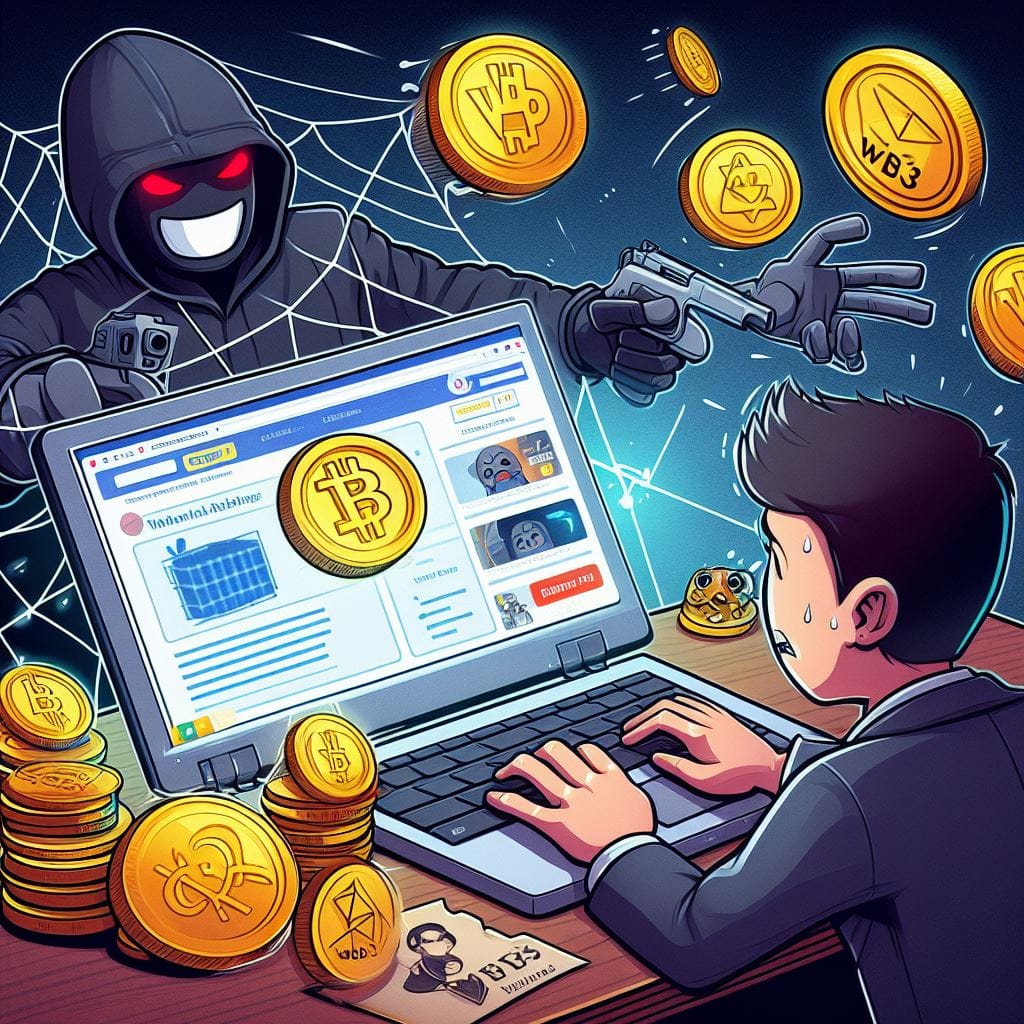Why Web3 is a Scam and a Fad

Web3 is the latest buzzword in the tech industry, promising to revolutionize the internet by creating a decentralized, peer-to-peer, and trustless network of applications and services. Web3 enthusiasts claim that this new paradigm will empower users, foster innovation, and challenge the dominance of big tech companies. Or so they claim.
Well then - "Web3" applications have been on the market for years and this point and there's no single app or idea that make good use of them. It's filled to the brim with scams and people trying to earn a quick buck from those gullible enough.
In this post, I will argue that Web3 is nothing but a scam and a fad, based on the following reasons:
Web3 is not decentralized
One of the main selling points of Web3 is that it is decentralized, meaning that there is no central authority or intermediary that controls the network or the data. However, this is far from the truth. In reality, Web3 relies on a few powerful actors that have a disproportionate influence and power over the network. These actors include:
- Miners: Miners are the ones who validate transactions and secure the network by solving complex mathematical problems. However, mining is a very expensive and energy-intensive process, which creates a high barrier to entry and leads to centralization. According to a recent report, more than 65% of Bitcoin’s hash power is concentrated in China, which poses a significant security and political risk. Moreover, miners have the ability to censor transactions, manipulate fees, and fork the network, which undermines the trustlessness and immutability of the network.
- Developers: Developers are the ones who create and maintain the protocols and applications that run on the network. However, developers are not neutral or benevolent actors, but rather have their own agendas and interests. Developers can introduce bugs, backdoors, or malicious code into the software, which can compromise the security and functionality of the network. Moreover, developers can change the rules of the network, such as the supply, the consensus mechanism, or the governance model, which can affect the value and the rights of the users.
- Exchanges: Exchanges are the platforms that allow users to buy, sell, and trade cryptocurrencies and tokens. However, exchanges are not decentralized or trustless, but rather centralized and custodial. Exchanges require users to surrender their private keys and personal information, which exposes them to hacking, theft, or surveillance. Moreover, exchanges can manipulate the prices, volumes, and liquidity of the market, which can create artificial bubbles and crashes.
Web3 is not user-friendly
Another major drawback of Web3 is that it is not user-friendly, meaning that it is not accessible, convenient, or intuitive for the average user. Web3 requires users to have a high level of technical knowledge and skills, as well as a high tolerance for risk and volatility. Some of the challenges that users face include:
- Complexity: Web3 involves a lot of complex concepts and jargon, such as cryptography, consensus, smart contracts, DAOs, NFTs, DeFi, etc. Users need to understand how these concepts work and how they affect their rights and responsibilities. Users also need to manage their own wallets, keys, and passwords, which can be confusing and cumbersome.
- Cost: Web3 involves a lot of costs and fees, such as gas fees, transaction fees, network fees, etc. Users need to pay these fees every time they interact with the network, which can be expensive and unpredictable. Users also need to invest in hardware, software, and bandwidth, which can be costly and inefficient.
- Risk: Web3 involves a lot of risks and uncertainties, such as hacks, scams, frauds, errors, bugs, etc. Users need to trust the code and the network, which can be faulty or malicious. Users also need to deal with the volatility and speculation of the market, which can be stressful and irrational.
Web3 is not innovative
Nothing innovative came out from Web3 after all these years - meaning that it does not offer any real value or benefit to the users or the society. Web3 claims to enable a new wave of applications and services that are more transparent, fair, and efficient. However, in reality, Web3 is mostly hype and noise, with little substance or utility. Most of the applications and services that Web3 offers are either:
- Redundant: Web3 replicates or copies existing applications and services that already work well on the traditional web, such as social media, e-commerce, gaming, etc. However, Web3 does not improve or enhance these applications and services, but rather makes them more complicated and expensive. For example, Twitter is a simple and popular platform for microblogging, but Web3 alternatives such as BitClout or Voice are more complex and costly, with no clear advantage or incentive for the users.
- Niche: Web3 caters to a niche or fringe market that has little demand or relevance for the mainstream users, such as art, collectibles, gambling, etc. However, Web3 does not create or satisfy any real need or problem, but rather exploits or creates artificial ones. For example, NFTs are a craze for digital art and collectibles, but Web3 does not provide any proof of ownership, authenticity, or scarcity, but rather relies on hype and speculation.
Web3 is not necessary
Another reason why Web3 is a scam and a fad is that it is not necessary, meaning that it does not solve any real problem or provide any real benefit that cannot be achieved by the existing web. Web3 claims to enable a new level of ownership and monetization for the users, especially for digital assets and content. However, in reality, Web3 is redundant and irrelevant, as there are already platforms and services that offer similar or better features and functionalities. One example is Steam.
Steam has a marketplace where users can buy, sell, and trade skins, which are cosmetic items that change the appearance of weapons and characters in games such as Counter-Strike 2. Skins are digital assets that have value and demand, as they can enhance the gaming experience and express the personality and style of the players. Steam allows users to own and sell their skins without any web3 or blockchain technology, using much simpler and secure methods.
Steam’s marketplace is an example of how users can own and monetize their digital assets and content without the need for web3 or blockchain technology. Steam’s marketplace is more user-friendly, cost-effective, and secure than web3 alternatives, as it does not require users to deal with complex concepts, high fees, or risky transactions.
Steam’s marketplace is also more innovative, as it offers a variety of games, genres, and communities that cater to different tastes and preferences. Steam’s marketplace is not a scam or a fad, but rather a proven and popular platform that has been serving millions of users for over a decade.
Web3 is not scalable
Another problem with Web3 is that it is not scalable, meaning that it cannot handle the increasing demand and usage of the network. Web3 relies on blockchain technology, which is a distributed ledger that records and verifies every transaction on the network. However, blockchain technology has some inherent limitations that affect its performance and efficiency. Some of these limitations include:
- Throughput: Throughput is the number of transactions that can be processed per unit of time. However, most blockchains have a low throughput, as they can only process a few transactions per second. For example, Bitcoin can only process about 7 transactions per second, while Ethereum can only process about 15 transactions per second. This is far below the capacity of traditional payment systems, such as Visa, which can process about 24,000 transactions per second. This creates a bottleneck and a backlog of transactions, which leads to delays and congestion on the network.
- Latency: Latency is the time it takes for a transaction to be confirmed and finalized on the network. However, most blockchains have a high latency, as they require multiple confirmations from different nodes to reach consensus and validate a transaction. For example, Bitcoin requires an average of 10 minutes to confirm a transaction, while Ethereum requires an average of 15 seconds. This is far slower than the speed of traditional payment systems, which can confirm a transaction in a matter of seconds or milliseconds. This creates uncertainty and frustration for the users, who have to wait for a long time to receive or send their funds.
- Storage: Storage is the amount of space that is required to store the data and history of the network. However, most blockchains have a high storage requirement, as they store every transaction and every state of the network on every node. For example, Bitcoin requires about 350 GB of storage, while Ethereum requires about 1 TB of storage. This is far larger than the size of most devices and servers, which limits the number of nodes that can participate and store the data. This creates a challenge and a cost for the users, who have to download and sync the entire blockchain to access the network.
Web3 is not secure
Another issue with Web3 is that it is not secure, meaning that it is vulnerable to various attacks and threats that can compromise the integrity and functionality of the network. Web3 relies on cryptography and consensus to ensure the security and validity of the network. However, cryptography and consensus are not foolproof, and they can be broken or manipulated by malicious actors. Some of these attacks and threats include:
- 51% attack: A 51% attack is a scenario where a single entity or a group of entities controls more than 50% of the network’s computing power, which allows them to manipulate the network and reverse transactions. This can result in double-spending, censorship, or theft of funds. For example, in 2018, Bitcoin Gold, a fork of Bitcoin, suffered a 51% attack that resulted in the loss of $18 million worth of coins.
- Sybil attack: A Sybil attack is a scenario where a single entity or a group of entities creates multiple fake identities or nodes on the network, which allows them to influence the network and disrupt the consensus. This can result in denial-of-service, spamming, or fraud. For example, in 2016, Ethereum Classic, a fork of Ethereum, suffered a Sybil attack that resulted in the disruption of the network and the delay of transactions.
- Smart contract bugs: A smart contract bug is a scenario where a smart contract, which is a self-executing code that runs on the network, contains an error or a vulnerability that can be exploited by hackers or users. This can result in the loss, theft, or manipulation of funds or data. For example, in 2016, The DAO, a decentralized autonomous organization that ran on Ethereum, suffered a smart contract bug that resulted in the theft of $50 million worth of ether.
Conclusion
I rest my case - Web3 is a scam and a fad, because it is not decentralized, not user-friendly, and not innovative. Web3 is a bubble that will burst sooner or later, leaving behind a trail of disappointment and disillusionment. Web3 is not the future of the internet, but rather a distraction and a diversion from the real issues and challenges that we face.
Web3 is not worth your time, money, or attention. Web3 is a waste of resources, energy, and potential.
Web3 is a lie.





